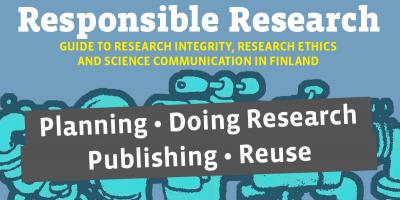In science publishing, questions relating to authorship may once more become a topic of debate.
A publisher wants to publish interesting and important literature and successfully bring the agreed publication projects to readers. One unique feature of scientific publication is the completion of a high-quality peer review procedure. For this reason, the publication process involves evaluation, feedback and editing phases, during which questions regarding authorship may sometimes once more become a topic of debate.
“Work” and “author” are central concepts of copyright law, which govern the work of the publisher. Traditional publishers earn a living from reproducing and selling copies of works for which the publisher has a publishing contract. The work is associated with financial and moral rights. The author may transfer their financial rights, for example to the publisher, but moral rights are not usually transferred. Moral rights mean that the author is recognised and credited as the author of the work and no-one else has the right to change the work. It is essential for the publisher to know the name of the author of the work in order to agree on its publication.
It is the heartfelt wish of publishers that authorship is agreed before contact is even made with the publisher. Publishers ideally seek to remain uninvolved in any authorship dilemmas and have no desire to take on the role of mediator in authorship negotiations. However, unclear authorship is also the publisher’s problem. The Finnish Copyright Act states that if the name of the author is not indicated in the manner described in the Copyright Act, the editor or the publisher shall represent the author. It is thus in the interest of the publisher that the name of the author is clearly indicated on the copy of the work in the manner described in the Copyright Act.
It is the heartfelt wish of publishers that authorship is agreed before contact is even made with the publisher.
Many publishers seek to protect themselves from publishing material that is questionable under copyright law by including a clause in the publishing contract that makes the author liable if they include in the manuscript material that infringes another person’s copyright. In practice, it is impossible for the publisher to conduct watertight checks as to whether the manuscript of a new work includes plagiarised material, for example. If, after publication, the plagiarised author contests the publication, the publisher will also be involved and accused.
In the publishing contract, the author does not assign copyright to the publisher. The author only transfers “the right to reproduce a literary or artistic work by printing or a similar process and the right to publish it”. The publisher draws on the interpretation of the Copyright Act: “A person who has created a literary or artistic work shall have copyright therein...” (Copyright Act, Section 1). Creating a literary work is generally interpreted as meaning writing or co-writing. In general literature publishing, ghost-writing is interpreted as authorship; if one person dictates and another writes, the writer is the author. However, different agreements on authorship may be reached between the authors. The person who has copyright may transfer their copyright in the work partly or even entirely.
It rarely occurs to the writer that the publisher will also be interested in the layout and typography. Appearance, marketing and the bibliographical side are all related to this. The publisher will also have to consider what the back and the cover of a work involving several authors will look like. Will it only show the name of the first author, for example? Publishers’ lists of new publications, for example, also usually have a limited number of characters in which to list bibliographical information, which means that there will not be space for all the authors of a co-authored work. Publishers would prefer to see a solution whereby works do not have very many authors. Things will become complicated as soon as more than three authors are involved. We may also ask ourselves how credible it is that a work has a large number of authors or editors.
In communicating with the authors of the book, the publisher must in any case treat the whole group of authors and editors as if they were a single entity. In other words, the publisher does not engage in resolving differences of opinion between the authors.
When an edited collection of articles is involved, the editor is the person who takes care of communicating with the publisher. The roles and copyright of the editor and the writer are set out in the publishing contract which is entered into separately with each of them. The editor is responsible for bringing the material from the writers together and producing a complete manuscript. The editor also has full copyright over the structure of the work and the editorial material. Writers have copyright to their own part of the work but not to the work as a whole. The writers are also responsible for ensuring that they have all the rights to their own part of the book and that they have the right to grant the publisher the right to publish. For example, this will concern publication rights to the pictures and diagrams in the article, which may also be obtained by the editor or in special cases the publisher, if a separate agreement is entered into.
Regarding the publishing contract, close attention should also be paid to the terms of green open access (self-archiving) and potential embargo periods. To pre-empt potential future forms of publication, in publishing contracts publishers often request electronic publication rights even when these are not to be used immediately. Finnish publishers do not seize rights or limit open access out of greed but predominantly in order to enable their publishing business to survive. Unlike the international publishing giants, Finnish science publishers do not make a significant profit but are merely attempting to stay alive.
Below we highlight several of the questions that have arisen in science and non-fiction publishing in recent years.
The distinction between authors and editors
The basic question is whether the issue is of a collection of articles or a monograph written by several writers. Usually a work with multiple writers is a collection of articles which has one or more editors. Greater attention has been paid to the distinction between a collection of articles and a monograph than was previously the case due to the Publication Forum classification and this linked to its application in the university funding distribution model.
In a monograph, the whole group of authors is responsible for the whole text, whereby the copyright to an individual chapter and the findings it contains is also held by the whole team of writers. For example, it is worth a young researcher considering whether in consenting to this kind of procedure, they may be transferring copyright to the key findings of their doctoral research to the entire research group. Cases have indeed arisen in which an individual writer did, however, want their own chapter of the book solely under their own name, in other words seeing it as their own article.
The monograph interpretation is only justified when the entire research group has produced findings and genuinely written about the research collaboratively. The different roles of members of the group of writers can be signalled by means of the order in which their names are shown if this deviates from alphabetical order. In such cases, the author with responsibility, the corresponding author, is shown first.
In crediting a large number of authors, the publisher is guided by Finnish Standards Association standard SFS 4414. According to the standard, the editor is stated on the title page but a long list of authors may be printed on the other side of the title page. The basic assumption is authorship, and differing roles must be clearly distinguished, e.g. “editor” or “edited by”, “illustrator”, “translator”, and so on.
Copyright of editors and writers
Sometimes it may be the case that a writer has a more urgent need to bring the work to the market than the editor does. At this point, the editor’s copyright over the whole of the work in relation to the writers’ right to their own part of it enters the picture. It is always worth aiming to reach an amicable solution through negotiation. If the situation cannot be resolved at all, the team of writers may abandon the entire project and start a new one.
To cover one’s back in extreme cases, it may be necessary to obtain a statement from a lawyer in case of disputes regarding the matter. For example, even the head of a research group is not generally considered to have the right to prevent the publication projects of their subordinates if the problem has arisen in an editing process – and this would not be to the benefit of the employer either. The publisher, however, hopes that the editing process does not hit a brick wall and seeks always to attain a satisfactory solution for all copyright holders.
Plagiarism and authorship
Problems arising regarding scientific publications are not generally associated as much with authorship as they are with questions of plagiarism. These too, fortunately, only occur rarely. Suspicions of plagiarism are usually raised by an eagle-eyed peer reviewer.
Plagiarism is not always the typical case of a word-for-word quote from another work without citing the source or using quotation marks. Sometimes the referee notices self-plagiarism, in other words long directly quoted sections from an earlier publication by the author without these being clearly stated to be such.
The most ambiguous cases involve suspicions of idea theft where the original source of the idea is not mentioned. Citing of sources may also be deficient such that the role of the source in presenting the idea is not highlighted and the idea is presented under the writer’s name. In plagiarism too, the issue is fundamentally one of authorship but at a different level than crediting the writers, editors and any other people involved.
Research group as author
Under Finnish law, the inventor of the idea of the book is not assigned copyright to the written work. Copyright rests with the person who realised the idea, the writer. To the research group, the book is often a side product of the research project, the most important thing is the research findings. On the other hand, they too are generally credited by source citations. In terms of copyright to the book, what is instead essential is who has created the written appearance of the work, i.e. written it.
At the moment, different disciplines have different practices regarding crediting the research group as the authors of the work. In the humanities, traditional authorship and the traditional role of editor generally apply. In those disciplines in which research has long been the work of research groups (especially the laboratory sciences) there has been a custom to write the name of the head of the research group last in the list of authors. The head of the research group has been considered to be the central source of the idea. In inter- and multidisciplinary projects, the head of the research group may be credited in the acknowledgements to the work but not credited as an author. A researcher who has come from a different tradition may view this situation as theft of ideas. It is thus important to agree authorship as early as when drawing up the publishing plan.
It will also be interesting to see whether the Ministry of Education and Culture’s funding distribution model will see practices change towards the largest possible group of authors gaining their names on the work. As long as the members of the research group are employees at the same institution, the funding distribution model will have no effect but the shares of different institutions are not allocated, so in research groups spanning more than one university there may be a benefit to having a representative of each party credited as an author. However, the publisher will want only those authors to be credited who have genuinely participated in writing the work.
Authorship in a wiki world
Electronic publication in particular brings with it new types of co-authorship (e.g. open collaborative authorship, see TENK’s Agreeing on authorship. Recommendation for research publications). Whether publication registers or library and research databases will keep pace with developments is a different matter. It is difficult to get researchers to participate in projects if they cannot be certain that they will be credited.
One example is the Bank of Finnish Terminology in Arts and Sciences [The Helsinki Term Bank for the Arts and Sciences], which is based on niche-sourcing. In other words, the idea is that researchers in each discipline take responsibility themselves for producing the terminology data in their field and updating it in the term bank’s wiki format online service. This means that a page or an article on a particular term may have many authors or editors. Their input can be seen in the number of characters in the page’s history information. However, in practice not that many authors are listed in the publication data and the number of authors may also be changing all the time. Attempts have been made to draw up guidelines for providing publication data. As more experience is gained of new forms of co-authorship, these are sure to be reinterpreted and made more specific.
Online platforms that favour editing and reusing material usually use a Creative Commons (CC) licence, which has various options. Some of these allow a large amount of freedom to edit the material and reuse it. It is a good idea to familiarise oneself with these and the criteria for crediting their authors to avoid unpleasant surprises.
The forms of publication are changing, is authorship?
The current Finnish Copyright Act mainly concentrates on the reproduction of a work and talks about reprints, which with the development of print-on-demand is an outdated discussion. It fails to fully describe the world of electronic publication in which book files are downloaded or shared for reading by other means.
From a publisher’s point of view, the most central element today is a written work productised with the author, which may be given different publication forms (a hardback or paperback book, e-book, audiobook...). A written work is a product which it is important to distinguish from other electronic material such as learning environments or various databases and archive material. A written work can be identified by its ISBN.
As different forms of co-working develop, it may also be the case that our concept of authorship changes too. At the moment, copyright is very central to academia and therefore it is important that the actual authors of the work have their input visibly and sufficiently clearly indicated.
Tero Norkola is Publishing Director of the Finnish Literature Society (SKS). Tiina Onikki-Rantajääskö is Professor of Finnish Language at the University of Helsinki. She heads the Bank of Finnish Terminology in Arts and Sciences and chairs the publication committee of the Finnish Literature Society.
Further information:
About the Licences. Creative Commons: https://creativecommons.org/licenses/ Finnish Standards Association’s standard SFS 4414.
Publication Forum: http://www.julkaisufoorumi.fi/en
Copyright Act. 8.7.1961/404: https://www.finlex.fi/en/laki/kaannokset/1961/en19610404
Including terminology work in a research data system and list of publications. Bank of Finnish Terminology in Arts and Sciences: http://tieteentermipankki.fi/wiki/Termity%C3%B6n_merkitseminen_tutkimust...
Agreeing on authorship. Recommendation for research publications. Finnish National Board on Research Integrity 2018: http://www.tenk.fi/sites/tenk.fi/files/TENK_suositus_tekijyys.pdf
Bank of Finnish Terminology in Arts and Sciences: http://tieteentermipankki.fi/w/index.php?title=Special:MyLanguage/Termipankki:Etusivu&setlang=en
You might also be interested in
Tämä teos on lisensoitu Creative Commons Nimeä 4.0 Kansainvälinen -lisenssillä. Detta verk är licensierat under en Creative Commons Erkännande 4.0 Licens. This work is licensed under a Creative Commons Attribution 4.0 International license.


